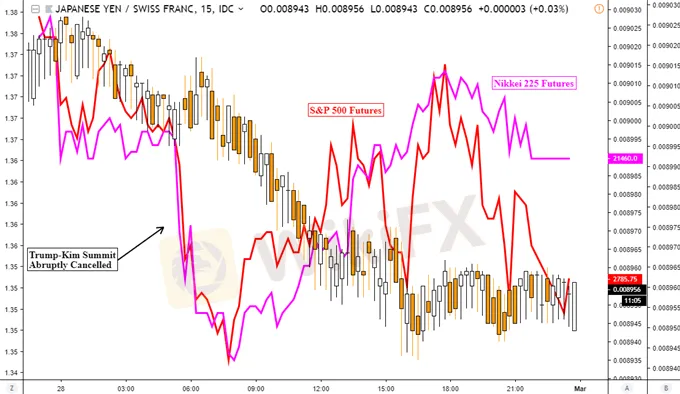简体中文
繁體中文
English
Pусский
日本語
ภาษาไทย
Tiếng Việt
Bahasa Indonesia
Español
हिन्दी
Filippiiniläinen
Français
Deutsch
Português
Türkçe
한국어
العربية
US GDP Fueled Gold Price Reversal Risk, USD Awaits Jerome Powell
Abstract:Better-than-expected US GDP boosted the US Dollar as gold prices tumbled. JPY/CHF fell as geopolitical risks in Asia rose. Equities may pause declines, all eyes
Asia Pacific Market Open Talking Point
The US Dollar soared on rosy GDP data as gold prices fell
JPY/CHF weakened as geopolitical risks increased in Asia
Asia stocks may pause declines, all eyes on Powell speech
See our study on the history of trade wars to learn how it might influence financial markets!
The US Dollar aimed higher against most of its major counterparts, boosted by a better-than-expected first estimate of fourth quarter GDP. Local front-end government bond yields rallied, singling increasingly hawkish Fed monetary policy expectations. This also boded ill for equities, which were already under pressure before the data release, as the S&P 500 closed lower for a third day.
Tensions between India and Pakistan as the Trump-Kim summit ended abruptly without an agreement were some of the causes of pessimism earlier in the day. These may have been why, unusually, we saw the anti-risk Japanese Yen weaken as its similarly-behaving cousin, the Swiss Franc, gain as a regional haven alternative. This is most clearly seen when looking at an intraday performance of JPY/CHF below.
JPY/CHF Fell as Asia Regional Risks Increased

Chart Created in TradingView
Some of the worst performing major currencies were the pro-risk Australian and New Zealand Dollars. Not only did they contend with a deterioration in risk appetite, but poor economic data also weighed them down. NZD/USD fell with souring business confidence. Soft Chinese manufacturing PMI data pressured AUD/USD lower as it underpinned economic growth slowing in the worlds second-largest economy. Gains in the US Dollar also boded ill for gold prices which turned lower this week so far as expected.
Fridays Asia Pacific Trading Sessio
Wall Street did trim some of its losses in the aftermath of commentary from US Trade Secretary Steven Mnuchin. He noted that there has been a lot of progress made in China trade talks. S&P 500 futures are pointing cautiously higher, perhaps leaving breathing space for Asia Pacific equities to pause some of their declines. Markets will be awaiting a speech from Fed Chair Jerome Powell.
US Trading Session Economic Event

Asia Pacific Trading Session Economic Event

Disclaimer:
The views in this article only represent the author's personal views, and do not constitute investment advice on this platform. This platform does not guarantee the accuracy, completeness and timeliness of the information in the article, and will not be liable for any loss caused by the use of or reliance on the information in the article.
Read more

Eye on Today’s U.S. GDP
Nvidia's highly anticipated earnings report was released yesterday, but despite the numbers beating market consensus, the performance lacked a "wow" factor for investors. As a result, the market seemed to have already priced in the earnings, leading to a decline in all three major indexes on Wall Street. Despite yesterday's technical correction, Nvidia's strong earnings suggest that the tech industry remains robust, with ongoing demand for Nvidia's chips potentially driving future gains

KVB Market Analysis | 28 August: Yen Strengthens on BoJ Rate Hike Hints; USD/JPY Faces Uncertainty
The Japanese Yen rose 0.7% against the US Dollar after BoJ Governor Kazuo Ueda hinted at potential rate hikes. This coincided with a recovery in Asian markets, aided by stronger Chinese stocks. With the July FOMC minutes already pointing to a September rate cut, the US Dollar might edge higher into the weekend.

KVB Market Analysis | 27 August: AUD/USD Holds Below Seven-Month High Amid Divergent Central Bank Policies
The Australian Dollar (AUD) traded sideways against the US Dollar (USD) on Tuesday, staying just below the seven-month high of 0.6798 reached on Monday. The downside for the AUD/USD pair is expected to be limited due to differing policy outlooks between the Reserve Bank of Australia (RBA) and the US Federal Reserve. The RBA Minutes indicated that a rate cut is unlikely soon, and Governor Michele Bullock affirmed the central bank's readiness to raise rates again if necessary to combat inflation.

KVB Market Analysis | 26 August: Bitcoin (BTC) Breaks Out Above $60,000, Faces Resistance at $72,000
Bitcoin traded above $60,000 on Friday, gaining over 4% this week but staying within a $57,000 to $62,000 range for the past 15 days. On-chain data reveals mixed signals, with institutions accumulating while some large holders are selling. Inflows into US spot Bitcoin ETFs and potential volatility from ongoing Mt.Gox fund movements could impact Bitcoin's price in the coming days.
WikiFX Broker
Latest News
SQUARED FINANCIAL: Your Friend or Foe?
Big News! UK 30-Year Bond Yields Soar to 25-Year High!
ACY Securities Integrates MetaTrader 5 to Enhnace Copy Trading Service
Soegee Futures Review: Should You Trust This Broker?
Malaysian Pilot Loses RM1.36 Million in UVKXE Investment App Scam
Indonesia officially joins the BRICS countries
Attention! Goldman Sachs Cuts Gold Target to $2910
Inflation Rebounds: ECB's Big Rate Cut Now Unlikely
Carney \considering\ entering race to replace Canada\s Trudeau
High-Potential Investments: Top 10 Stocks to Watch in 2025
Currency Calculator






